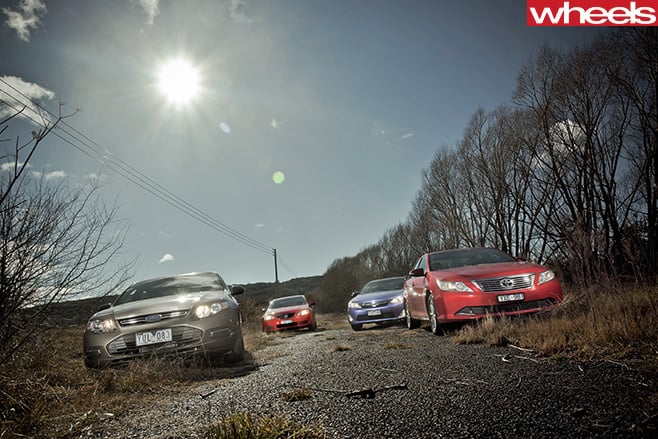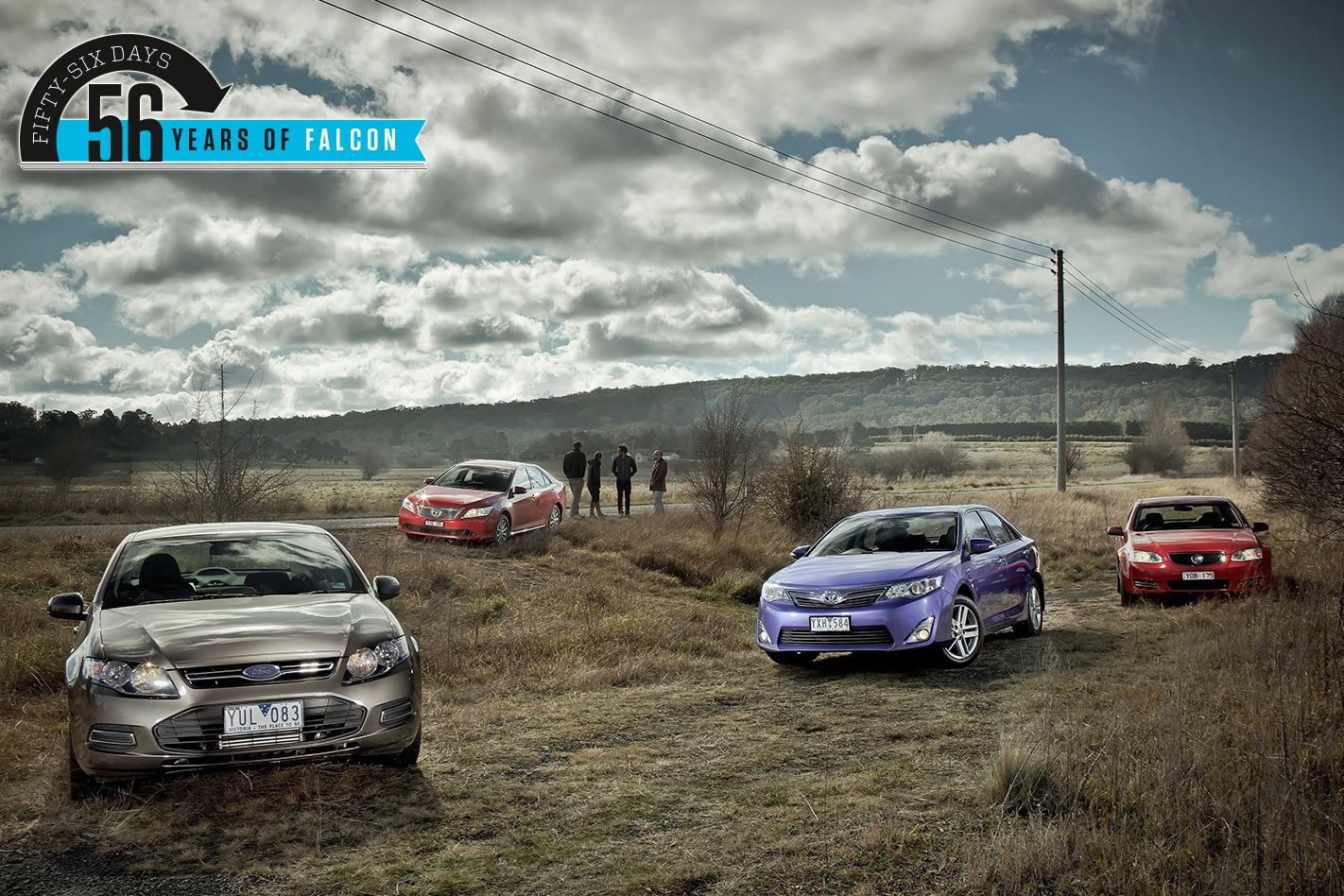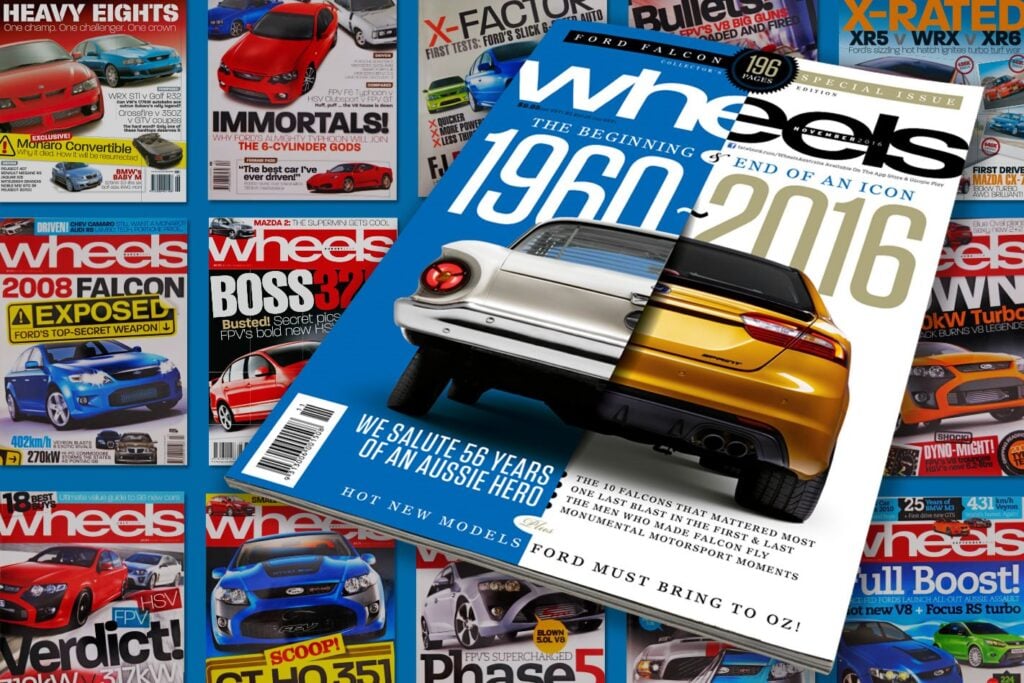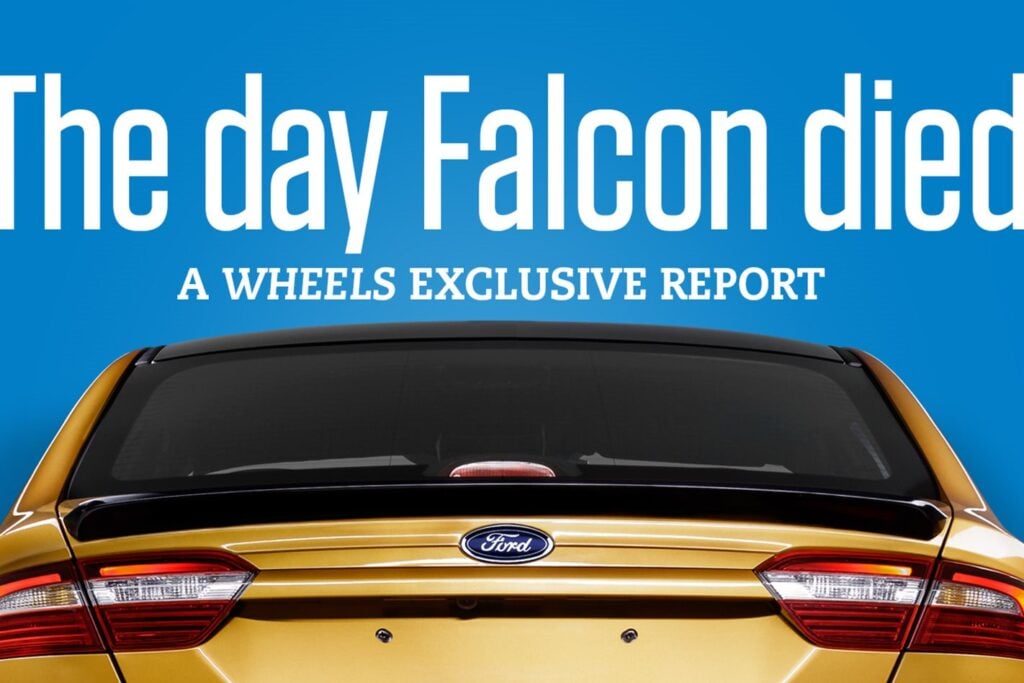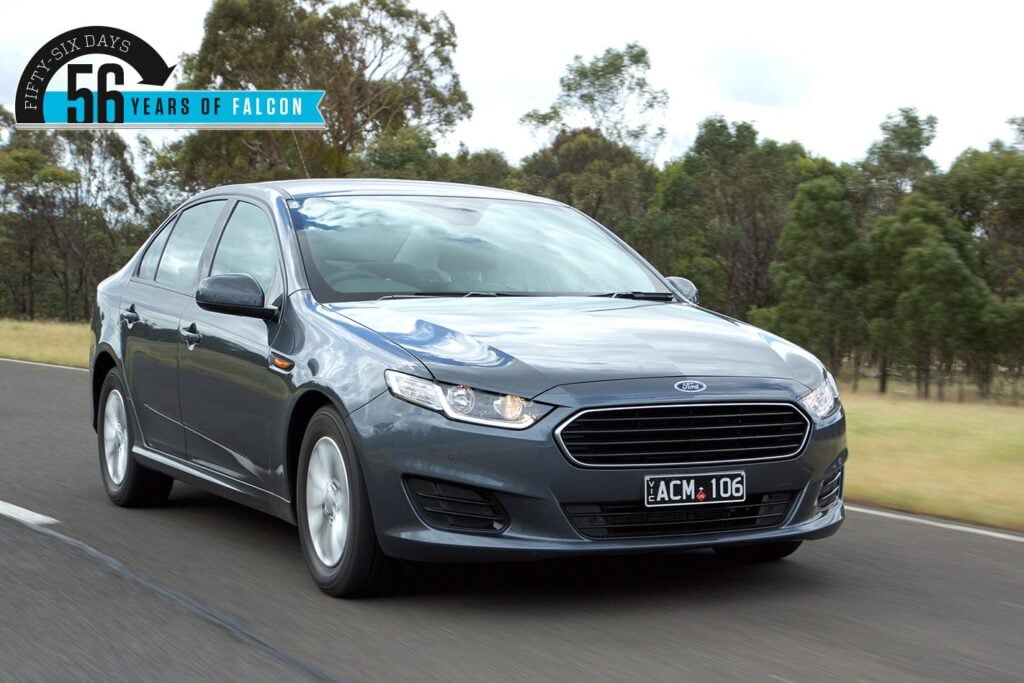First published in the August 2012 issue of Wheels magazine, Australia’s best car mag since 1953.
In this latest address to Aussie drivers, Falcon and Camry come to the four with boosted incentives, while Commodore and Aurion set out to prove that a six still has clout at the polls.
FAIRER critics of the Australian automotive industry point first to its continued need for taxpayer-funded grants, then to the sales charts, and quickly call for factory closures. Difficult to argue with if a country is run only by its balance sheet. Harsher opponents tag the industry as a lumbering dinosaur, unable to compete in a global environment and unworthy of funds to prolong its inevitable extinction. That bit requires a correction.
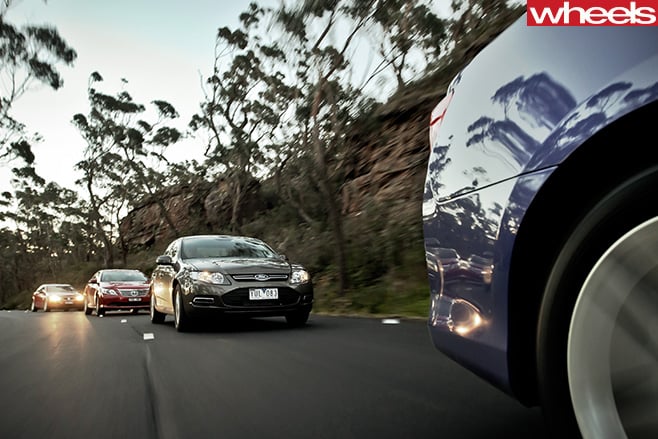
Official ADR consumption figures, and the waning popularity of large cars, is primarily what has driven changes to the old big-six formula. Bright spark of this group is the Camry Hybrid. The electric motor both takes a load off the 2.5-litre petrol four and helps boost combined outputs to 151kW and around 350Nm – properly six-pot competitive.
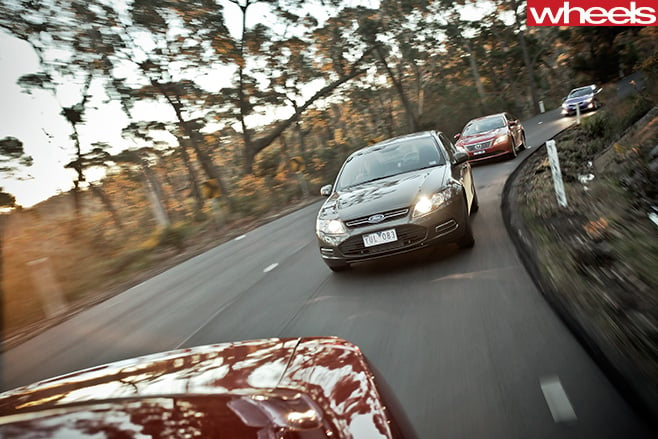
We’ve gathered a group of (mostly) base models. You recognise the badges – Omega, XT and AT-X. The Camry Hybrid HL is the luxury-grade exception, as a base H wasn’t available to test. However, although entry variants are fixtures on fleet and hire-car lists nationwide, there are a few reasons why base can be best. Without the fake carbonfibre or plastichrome inserts of sports and prestige variants (both are present on the Camry) the entry-level cars are attractively functional and utterly unpretentious. They also represent excellent value. Best to ignore their $37-42K recommended retail prices when ‘limited edition’ models are frequently flogged to private buyers, with more standard kit, for around $33K on-road.
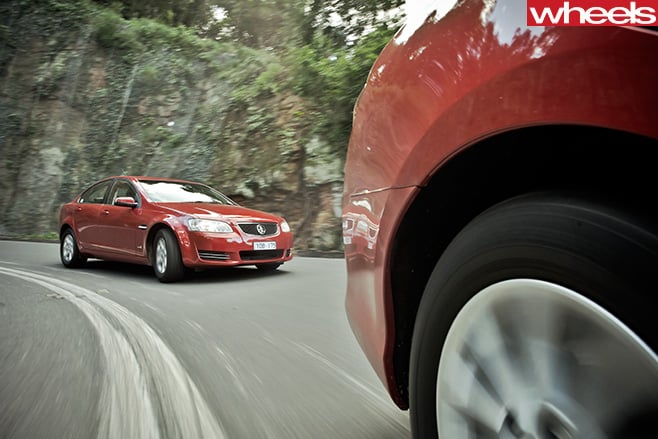
Just as an LPG cylinder robs taxi boot space, a battery-pack steals room from the Camry Hybrid’s rear, reducing its cargo capacity to a small-hatch-like 350 litres. That’s 165-litres less than the petrol-only Aurion, which also adds a split-fold rear seat. The 496-litre Holden only gets a ski-port, to the 535-litre Falcon’s split-fold, though both utilise bootlid gas struts, a far more elegant solution than the Toyota’s dated, luggage-crushing goosenecks.
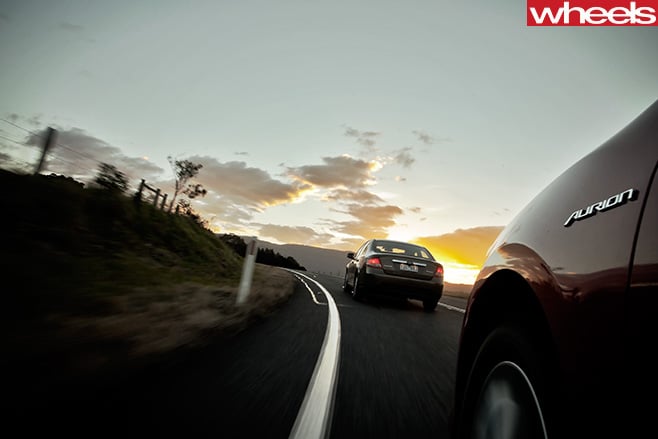
Ford’s entry-level FG is best for design and ergonomics, if not quality. Charcoal-grey plastics contrast nicely with the (optional and impressively intuitive) eight-inch colour touchscreen display, but there are brittle edges to its mismatched plastics, many of which don’t fit as well as they should.
Meanwhile, the six-year-old VE Commodore dash blends rubbery plastics with similarly sub-par finish. Despite a belated Series II update – if this were the VT generation, the VZ finale would soon be arriving – the addition of a colour touchscreen interface and the door grabs from the Caprice hasn’t lifted a cabin that screams desperation for next year’s VF overhaul.
Get driving, and the initial largely level playing field quickly shifts. Clearly it’s a fight between a four and a six for the best drivetrain here.
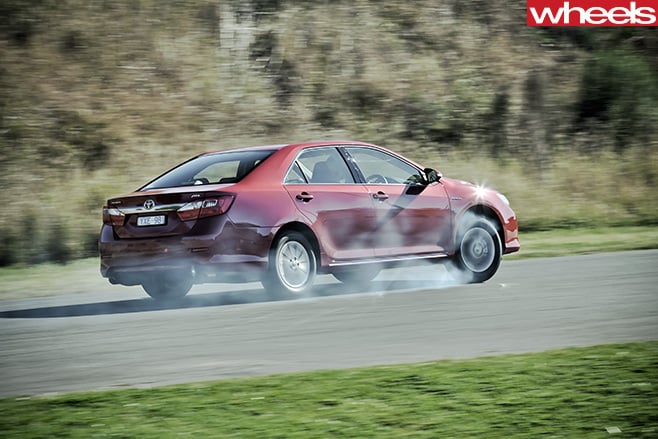
Only after driving the Aurion could you find the Falcon Ecoboost a fraction slow. The Toyota’s 3.5-litre/six-speed auto drivetrain is carried over from the 2006 first-generation, but this new model weighs 65kg less, at 1525kg. Forget comparing its performance with its rivals here – this humble entry-level sedan will frighten Subaru WRX and Commodore SS owners with its 6.1sec sprint to the 100km/h benchmark. But it’s only that brisk if you turn off the stability control and axle-tramp off the line (there are owners who will do this – see breakout). The V6 also has a lovely, raunchy engine note and a crisp-shifting auto that makes the Ford and Holden gearboxes feel slow. Surely you could safely bet on the Falcon beating the Aurion for consumption, though? Hold tight, Hansie Cronje.
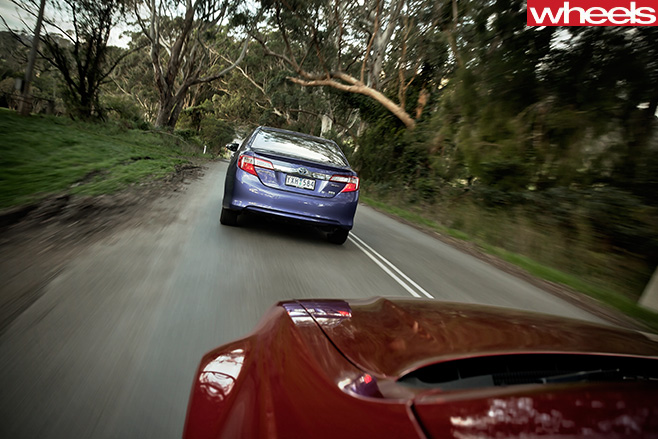
Ironically, those raised on a diet of effortless big sixes will feel more at home in the Falcon and Camry fours than the V6 Commodore. The all-alloy, 60-degree, direct-injected 3.0-litre isn’t what you’d call slow. It is, however, what you’d call harsh and hollow, an engine that struggles to propel this 1690kg sedan. The throttle needs to be treated like a cattle prod to urge the engine into its mid-range, necessary to maintain a set speed. The revised 6L45 auto is now keener to pick lower gears early, to help disguise the lack of torque, but it remains slow on the uptake; on one incline the engine couldn’t hold 80km/h in sixth, so the gearbox shuffled to fifth, but that necessitated easing the throttle to keep the same speed, which meant the auto immediately grabbed top again. Only after the gearbox hunted back and forth three times did it prudently hold the lower ratio, leaving the engine to spin (and presumably drink) hard.
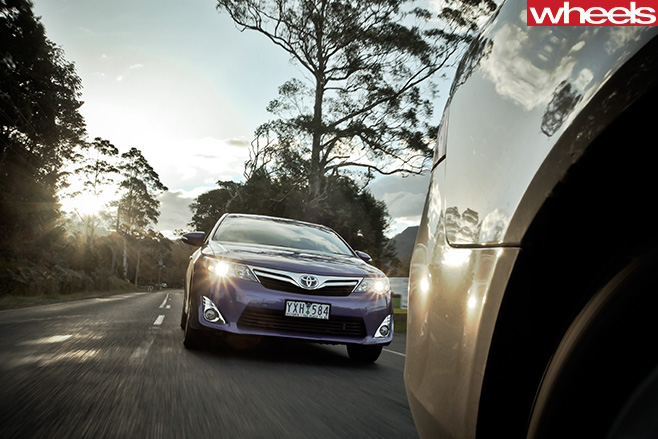
Yet, for outright cornering ability alone, the newly four-tified Falcon proves even better. Lifting 60kg off the front axle (compared with the six) has liberated the Ford’s front end. Where the VE is fluid, the FG Ecoboost is downright frisky. The immediacy of its turn-in surprises after stepping out of its more measured rival, the nose darting keenly towards the apex. That first tightening-radius corner approached at speed had my left foot hovering instinctively over the brake pedal mid-corner, expecting a trace of understeer. Instead, the Falc leans on its outside front tyre with commitment. Quickly spool-up the Ecoboost four and the rear boots pull the rope tight on your cornering line. The newfound agility, and lightness on its feet, feels incredible for a car this size.
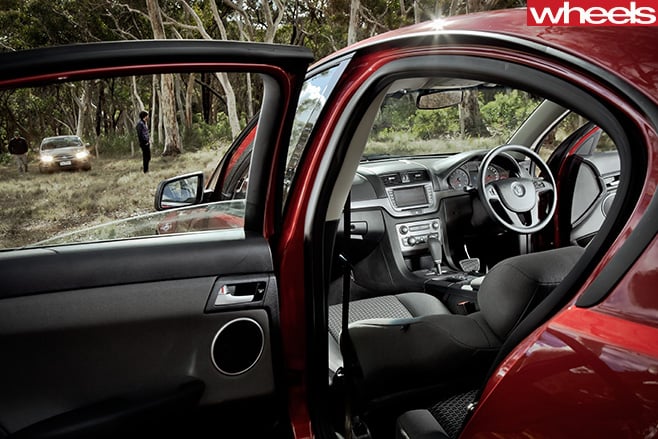
BA/BF generation has been reintroduced, the weight and connection of other FG variants has been lost.
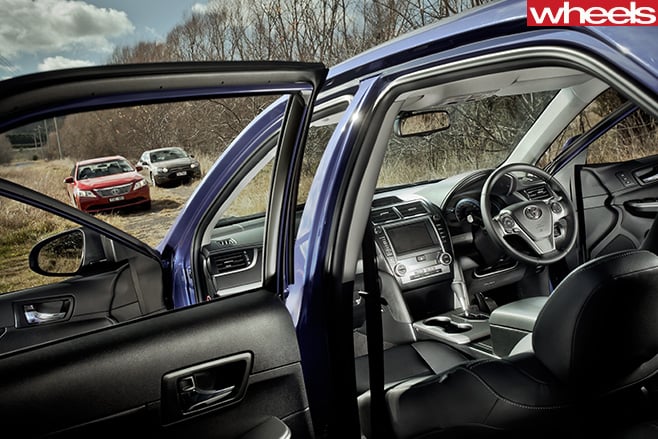
Swapping into the Camry Hybrid HL, which rolls on 55-aspect 17s, confirms the superiority of the Aurion on smaller hoops. The petrol-electric, mid-range Toyota is constantly restless, whether around town or on country backroads. Neither front-driver offers the tight-corner agility and verve of the rear drivers, succumbing early to understeer. However, the Camry demands its driver brake dee-e-e-p into a bend to maintain a cornering line, the rear unmoved to slightly slide with the fronts as the Aurion cooperatively does.
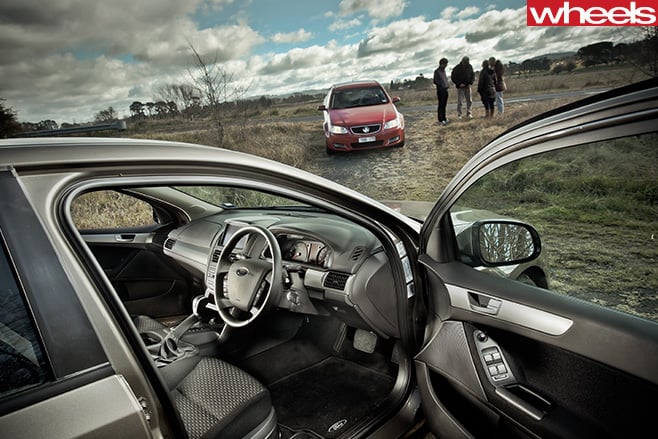
There are other reasons why the Camry is an inferior drive to its stablemate. Both electric steering set-ups share an on-centre vagueness and aren’t particularly quick; however, where the Camry’s is deadweight, the Aurion’s at least adds meatiness on rotation. The Camry’s regenerative braking feels wooden and touchy; the Aurion’s pedal is more progressive and natural.
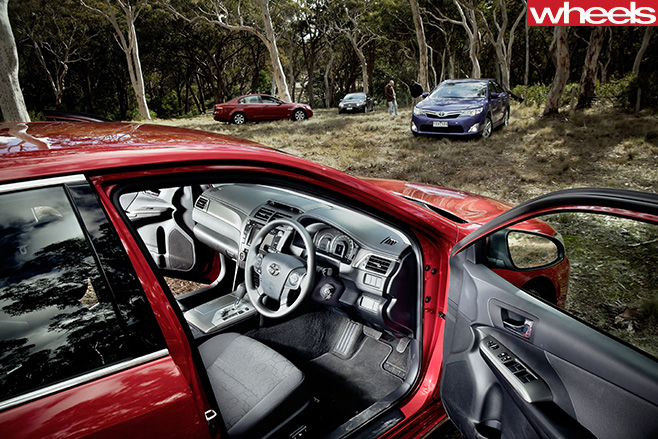
Swapping between the Aurion and Commodore serves to magnify their contrasting abilities – the Toyota V6 is a revelation after suffering the Holden donk, while the steering and handling of the Omega ousts the AT-X by a similar margin. The Aurion then steams ahead for cabin quality and quietness, and secures its silver medal at the bowser – its 3.5-litre engine slurped 9.5L/100km on test, just 0.2L above its combined ADR; the smaller 3.0-litre Commodore chugged 13L/100km, a full 4.1L above its offical figure.
